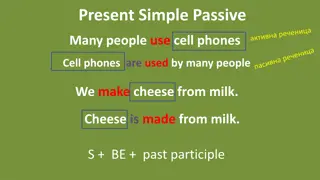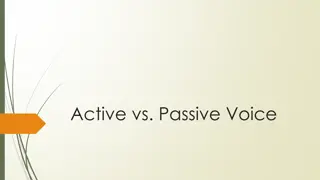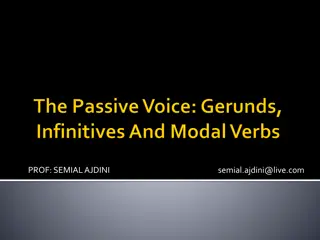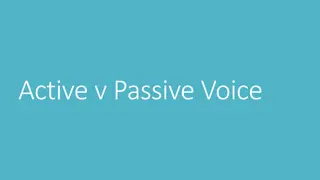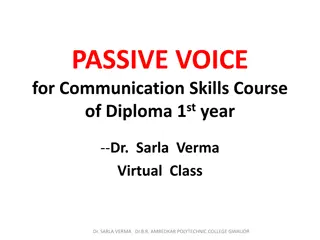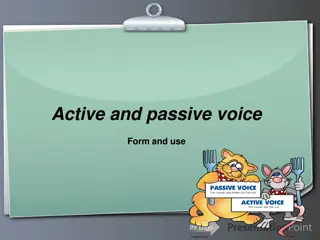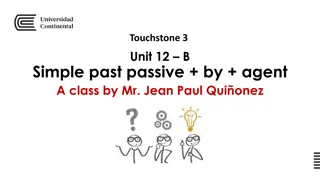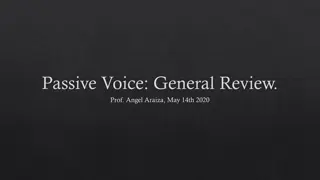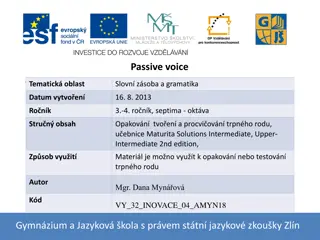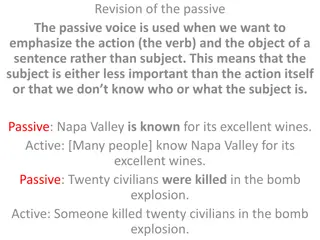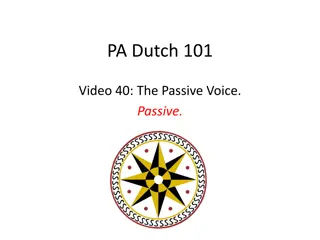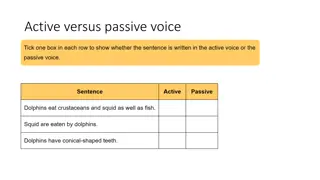Understanding Passive and Active Voice in English Language
Learn about the passive and active voice in English grammar, focusing on describing processes and actions where the doer is unknown or unimportant. Explore examples, differences between active and passive voice, and how to convert sentences from active to passive voice. Practice activities to enhance your understanding.
Download Presentation

Please find below an Image/Link to download the presentation.
The content on the website is provided AS IS for your information and personal use only. It may not be sold, licensed, or shared on other websites without obtaining consent from the author. Download presentation by click this link. If you encounter any issues during the download, it is possible that the publisher has removed the file from their server.
E N D
Presentation Transcript
Primer ao medio: Unit 3: The Arts Contents: Lesson 1: The passive and active voice. Objetives: Lesson 1: OA 8 Describir procesos y acciones realizadas en las que el agente es desconocido o no es importante; por ejemplo: the money was found on the floor; rooms are cleaned daily; plastic is produced from oil. - presente y pasado (subject + be + past participle) para describir procesos y acciones realizadas en las que el agente es desconocido o no es tan importante en la oraci n. Uso de voz pasiva en
Look at the following examples: Are the senses of both sentences the same? Who did the action (doer) in both sentences? Are the subjects the same in both sentences? Which sentence is more focused on the person who did the action? Which sentence is more focused on the action more than the person? Example 01: Cristopher Columbus discovered America. Example 02: America was discovered by Cristopher Columbus.
Active voice: The cat ate a mouse. The doer (the cat) is the subject of the sentence. The sentence is focused on the doer. Structure: Subject + verb + object. Pablo Neruda wrote many poems. My mum bakes cakes every day.
Passive voice: A mouse was eaten by the cat. The doer is still the doer, but this time it is the object of the sentence. The object becomes the subject. The sentence is more focused on the event rather than the person who did the action. The structure is different: Subject + verb to be (am, is, are, was, were) + past participle verb (third column). If you want to mention who did the action, you need to use by (sometimes, it is not necessary to say who did the action) Many poems were written by Pablo Neruda. Cakes are baked by my mum every day.
Activity 01: Which word is missing? Was or were? 100 years of solitude _____ written by Gabriel Garc a Marquez. Was La Gioconda _____ painted by Leonardo Da Vinci. Was Santiago and Conepci n _____ founded by Pedro de Valdivia. Were
Activity 02: Can you turn these sentences into passive? Beethoven composed the 5th symphony. The 5th symphony was composed by Beethoven. The thief was caught by the police. The police caught the thief. Titanic was directed by James Cameron in 1996. James Cameron directed Titanic in 1996.
Susan walks her dog every day. Susan s dog is walked by her every day. The baker makes bread daily. Bread is made (by the baker) daily. I watched a nice film last night. A nice film was watched by me last night. Egyptians built the great pyramids. The great pyramids were built by the Egyptians.
Video links: Active vs passive voice: https://www.youtube.com/watch?v=W1_IRU6zx 9g Song: https://www.youtube.com/watch?v=ARaEpSAD- ng
Exercises: Passive voice exercises: https://www.englisch- hilfen.de/en/exercises_list/passiv.htm









